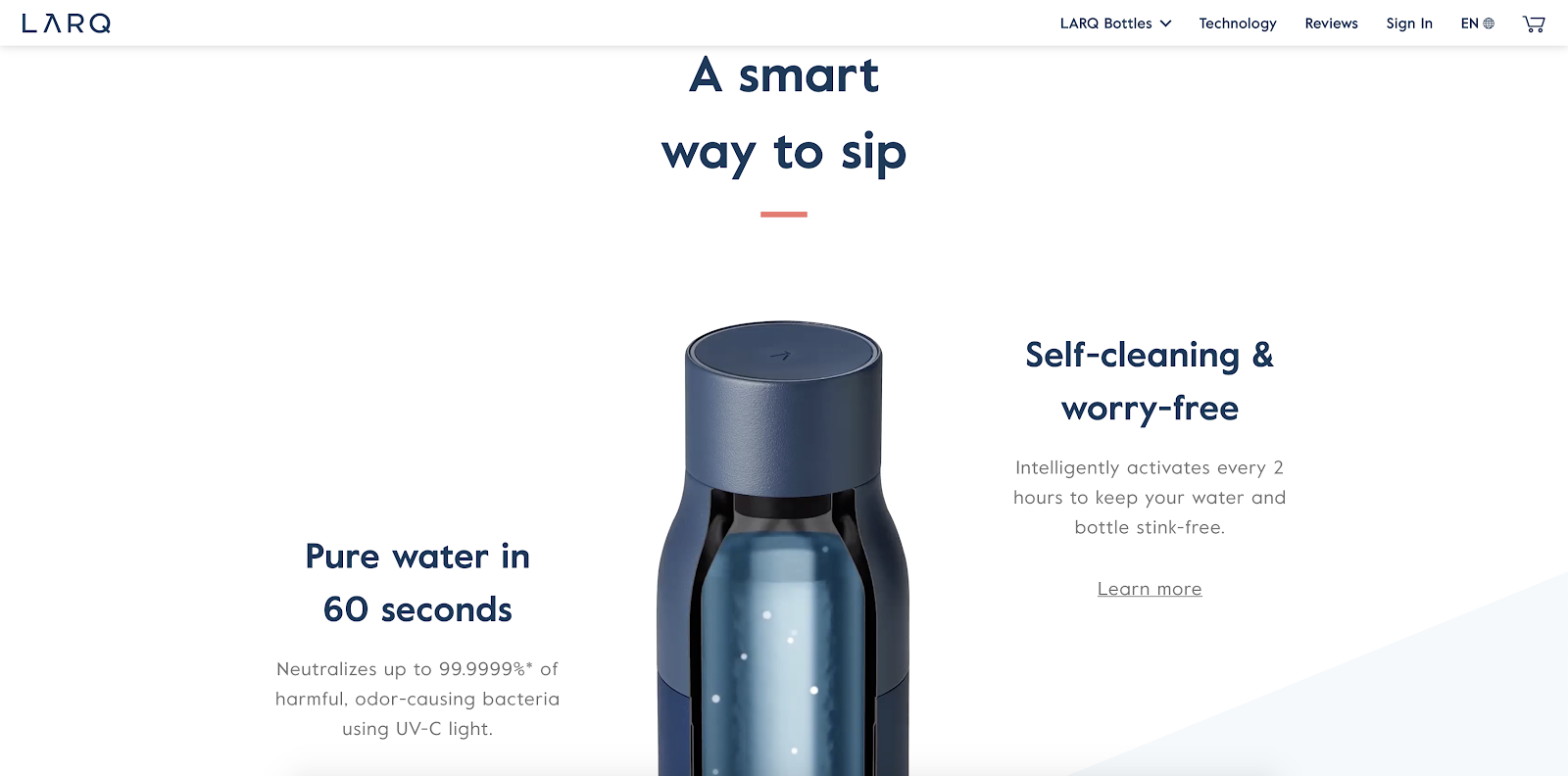Table of Contents
** Minutes
Headless ecommerce stores vs. traditional: what’s the difference?
Why go headless? 5 advantages to headless commerce.
Are there any downsides to headless ecommerce?
Top headless ecommerce platforms
Examples of headless ecommerce websites
At the NRF Conference in January 2020, there were numerous themes that became apparent through the tradeshow programming — before you even stepped into the doors of the conference hall:
- New ways to market to customers. Think about Gen-Z: they dislike fast fashion, and they respond well to emotive messaging and sustainable practices.
- New ways to reach customers. Tracks about SMS and email marketing filled the breakout rooms.
- And finally — new ways to incorporate original creative content into a historically rigid online environment.
This is where headless commerce comes in, giving rise to unique, fast, and memorable experiences for the customer. By breaking up the rigid barrier between your content and your transactional back-end, brands who use headless commerce have easier ways to connect with the customer through traditional content like video and written words — and other methods like custom shopping carts and added personalization.
What is headless ecommerce?
Headless ecommerce is a version of ecommerce that takes apart the front- and back-end layers of a website. By having the presentation layer separate from the technical solution, it becomes easier to add customization and personalization to the customer experience.
Headless ecommerce stores vs. traditional: what’s the difference?
With traditional on-premise and SaaS ecommerce stores, the front-end and back-end of the store is linked together (or “coupled”) — which limits the amount of customization developers can build into a store.
With headless commerce, the two ends are separated, which makes it easier for developers to make changes and adjustments.
The value most often seen by brands who use a headless approach is flexibility. The limitations that developers have for front-end customization inherently depends on the front-end technology they’re using. With headless ecommerce, you have the freedom to choose whatever front-end platform makes sense for your use case.


Why go headless? 5 advantages to headless commerce.
Making any sort of structural change to your website often requires the work of at least three people: a designer, a developer, and tester. So when it comes time to evaluate whether or not you need to completely overhaul the way your ecommerce store functions, you’ll need to first know whether or not you’ll get a return on your time and investment in the future.
So what are some of the advantages to using headless commerce over traditional ecommerce? It varies depending on your business requirements, but most often brands see the following benefits.
1. Omnichannel reach
The past few years have seen an influx of different ways for customers to shop online. Now, in addition to hopping into a brick-and-mortar store, customers can
- visit a marketplace like Amazon or Jet,
- go to a direct-to-consumer website,
- check out a peer-to-peer marketplace like Poshmark or eBay, or even
- start their purchase on a social media platform like Instagram or Facebook.
Previously, traditional ecommercestores had to go through significant development, testing, and monitoring in order to adapt their platform to new channels. But with headless commerce, you can easily integrate an omnichannel strategy and get your content onto new channels because your back-end and front-end are separated.
In addition, because headless is API-driven, you can more easily plug in commerce to new channels or emerging technologies.
2. Increased organic traffic
Headless commerce websites enable brands to lead with a content-first strategy, which often lends itself to successful search engine optimization.
By leading with content, and enabling quick adjustments to content, brands can attract website visitors without the rising cost of investing in paid marketing.
In addition, headless commerce allows for a more diverse mix of content on your website — think copy, video, interactive infographics, etc. — which will help to capture the attention of consumers who respond to different types of material.
3. Reduced customer acquisition costs
Driving traffic to your website with organic methods involves significantly fewer costs than paid methods.
Having a headless commerce website pairs a more powerful content-driven strategy with lower customer acquisition costs, which frees up budget for your other forms of marketing.
4. Design flexibility
With headless commerce, rather than being tethered to a template architecture, you can customize and personalize a site more easily.
Brands who are interested in getting more engagement (and more purchases) on their ecommerce website are often pleased with the way that headless architecture allows for quick iterations and changes on the front-end to meet shifting customer expectations.
Using headless ecommerce gives store managers the flexibility of a robust CMS like WordPress or Drupal, paired with the security of an ecommerce platform.
5. A/B testing
The quick rollouts and agile testing enabled by headless ecommerce allow you to optimize your content and marketing with A/B testing.
Legacy ecommerce platforms require either significantly more back-end work or an additional partner solution in order to implement any sort of paired testing — which requires more time than many retailers can afford.
Beyond A/B testing, headless ecommerce allows businesses to be more agile in general. Because headless commerce works by decoupling the front- and back-end systems of a website, you can make changes, test, and respond to market changes quickly with changes on the front-end without disrupting back-end functionality.
Are there any downsides to headless ecommerce?
Headless commerce is not a catch-all solution, and is often recommended to retailers who have a specific use case that requires a certain level of complexity that is not often solved by out-of-the-box solutions.
While every type of ecommerce platform has its pros and cons, the downsides associated with headless commerce sometimes leave brands turning to alternative solutions.
The main takeaway for brands is that a simple ecommerce solution typically works for small businesses and startups that don’t require many functions outside of the original product scope. But as they grow and require additions to their tech stack in order to meet up with customer and order fulfillment requirements, a migration to headless commerce is a common solution.
Development/design costs
The cost of customized front-end development and design can be significant.
If you’re a brand with a limited budget who doesn’t need many changes to basic ecommerce functionality, you may consider shifting your budget elsewhere — but keep in mind the sacrifices you’re making to your content functionality.
Added complexity
While templates are seen as the go-to solution for many beginner brands, the sophistication and customization associated with content-rich retail often comes with some complexity.
Headless ecommerce adds another layer that you need to keep track of, rather than just using a template — but that may be a benefit for particular types of brands.
Constant need for change
The way consumers shop is no longer linear. There are more touchpoints, interactions, and decisions involved with a retail purchase than ever before.
Because of this, ecommerce stores have to make changes to their website on a daily basis — instead of monthly or even yearly, as it was in decades prior.
If you’re implementing a headless commerce solution, it’s important to be aware of the additional hours and resources associated with this high level of adaptability. But, once a headless solution is implemented, it can be easier to make changes quickly. Make sure you weigh the pros and cons before diving in.
Top headless ecommerce platforms
Over the past several years, a rising number of legacy and newer ecommerce platforms have expanded their suite of products to accommodate customers who may benefit from a headless approach.
The best route to take in evaluating a platform is to understand the benefits and limitations of each, in addition to the costs associated with onboarding or replatforming. Here are some of the top ecommerce platforms that offer headless ecommerce solutions:
BigCommerce
The first platform to introduce a fully headless product, BigCommerce is often seen as the leading headless commerce platform.
BigCommerce has pre-built integrations with the most popular CMSs, DXPs, PWAs, and more — including WordPress, Drupal, Bloomreach, Adobe Experience Manager, and more. BigCommerce also provides the ability for merchants to use BigCommerce with any front-end technology of choice.
The BigCommerce headless commerce technology fuels hundreds of international brands like LARQ, Burrow, and Firewire Surfboards.
Shopify
As one of the leading ecommerce platforms available to a wide range of brands, it makes sense that Shopify recently expanded their product to allow for headless integrations.
By giving full creative control to the already-flexible SaaS front-end, Shopify merchants can get true value out of the platform depending on their use case.
WordPress
While WordPress itself is a CMS and not an ecommerce platform, the system’s open architecture allows retailers to build in and develop ecommerce functionality while also maintaining the content-rich use cases that WordPress is widely known for.
The three most popular shopping cart add-ons for WordPress are WooCommerce, the BigCommerce for WordPress plug-in, and the ShipBob 2-Day Express Shipping Program plug-in.
Magento
Magento made its stake in the ecommerce marketplace by being one of the most robust and extensible platforms available. Because of the security and performance issues often seen by older users of the Magento platform, many newer builds on Magento will often take advantage of at least some portion of the build being headless.
The most common way to build headless on Magento is by using a progressive web application (PWA) or a headless content management system like Contentful.
One thing to keep in mind is that not every Magento version or feature has the API extensibility you need out-of-the-box, which may require additional development hours to complete.
Shogun
Shogun integrates with leading ecommerce platforms, including Shopify, BigCommerce, and Magento, to make it easy to build custom pages for your online store. You can build anything from optimized landing pages to product pages with no coding required. Shogun also makes it easy to measure page performance and monitor ecommerce metrics from form submissions to cart conversions.
Examples of headless ecommerce websites
Because headlesscommerce websites are often built to mirror the design of out-of-the-box websites, it can be hard to distinguish between the two types until you look at the back-end.
Consumers are more-or-less blind to the “inner workings” of a website, because the user experience of a website should ideally remain the same no matter what technology is powering things behind the scenes.
Headless commerce is most often used for more technologically complex builds that require many different systems to work together. The visible benefits typically seen by a brand moving from a legacy build to a headless build usually include faster page load times, more customized product and/or educational content, and custom checkout experiences.
LARQ


The LARQ website is custom-built on the front-end using React and the back-end using BigCommerce. The LARQ team uses multi-site functionality to fuel four regional sites.
Firewire Surfboards


Built using the BigCommerce for WordPress plug-in, the Firewire Surfboards website uses the WordPress CMS as the front-end, and BigCommerce as the back-end.
Burrow


The Burrow website is powered by a custom CMS on the front-end, and BigCommerce on the back-end.
In an interview with BigCommerce, co-founder and CEO Stephen Kuhl remarks:
“We’ve solved for the problem of bringing an in-person shopping experience online by creating visual content — for example, shooting photography or videography that communicates comfort by showcasing all the attributes of the sofas, the way real people are living these days.”
Drive more revenue with optimized fulfillment
There are many different ways in which ecommerce brands can work to better their business. A lot of brands tend to take a holistic approach where they look at all aspects of the business from web, to marketing, to customer support, all the way through to order fulfillment.
One of the first areas brands should look at is last-mile efforts with optimized fulfillment logistics. Customers continue to demand more from their ecommerce experiences, and the way the product makes its way to them is no exception.
If you’re an ecommerce brand who just wrapped up a new development project (like headless commerce) — perhaps take a look at shipping and fulfillment as your new place to iterate and grow.
Conclusion
Gone are the days of “set-it-and-forget-it” website building. Now, brands need to make changes on a weekly (or even daily) cadence to stay relevant, capture customers, and continue to build a base of loyal followers.
Many brands find that headless commerce is a technology that helps them fuel this adaptability. By removing the barriers between the front- and back-end structures of a website, headless ecommerce lets merchants fully focus on custom content, checkout optimization, and other tech advancements.



